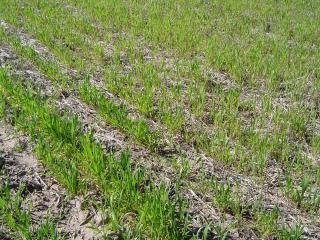Western Australia
June 25, 2015

Nitrogen deficiency in a young cereal crop.
Grain growers have been urged to tissue test their crops to help guide rates for additional nitrogen fertiliser application.
Recent rainfall has provided an ideal opportunity for growers with crops that are tillering to tissue test in order to gain a reliable picture of whether nitrogen supply is adequate.
Department of Agriculture and Food research officer Craig Scanlan said the effect of a prolonged dry period on soil nitrogen supply could be hard to judge.
Dr Scanlan said that some areas within the wheatbelt would have had enough days where the soil was sufficiently moist for mineralisation to get started, while others would only now be seeing the start of mineralisation.
“Nitrogen mineralisation from organic matter into plant available forms is dependent on the soil being moist as mineralisation stops when soils are dry,” he said.
“Nitrogen from organic matter usually provides 40-80 kilograms of nitrogen per hectare over the growing season. The dry conditions during May and early June could mean that crops will be more dependent on nitrogen supplied as fertiliser.
“Tissue testing gives a valuable snapshot of nitrogen status in your crop; it tells you if the nitrogen supply from the soil and up-front fertiliser has kept up with the demand from the crop.”
Tissue testing services are available from fertiliser companies and some farm merchandise stores.
Pale strips of crop in header trails are a visual clue that nitrogen supply is marginal or low. Further details are available from the department’s MyCrop diagnosis website and app, or by searching ‘nitrogen’.
Dr Scanlan recommended that growers prioritise paddocks for tissue testing to ensure value for time and money.
“Paddocks with low soil organic carbon, particularly those with less than about 0.8 per cent, are worth going to first, as are paddocks where more nitrogen has been removed in grain than was applied last year, or those where low starter nitrogen fertiliser rates have been applied in 2015,” he said.
“As a rule of thumb, one tonne per hectare of wheat removes 17 kilograms of nitrogen per hectare.”
Recent work by the department’s Mark Seymour shows that nitrogen applied to canola up to mid-flowering can generate yields equivalent to earlier application. Similarly cereals can have most nitrogen delayed until early stem elongation or growth stage 31 if plant or tiller density is high.
Information on the critical nitrogen concentrations at different growth stages for by wheat, barley and canola crops to achieve maximum growth rates is available on the department’s website by searching for ‘crop nutrition’.
“At tillering, wheat and barley crops need about 4.5 per cent total nitrogen to optimise growth,” Dr Scanlan said.
Information to assist growers about the timing of split nitrogen applications is available on the department’s website by searching for ‘nitrogen’.